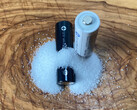Let someone else say that particle accelerators have no impact on everyday life. Experiments at the synchrotrons BESSY II and PETRA III at the Helmholtz-Zentrum Berlin, Germany, could have a major impact on all our mobile devices - including, of course, EVs, e-bikes and more.
In both facilities, it was possible to take a look at the anodes and cathodes of normal lithium-ion batteries during charging. More specifically, the focus was on ageing processes at a molecular level, which gradually deteriorate the general condition of rechargeable batteries with each charging process. Raman and X-ray spectroscopy were used to identify individual molecules based on the scattering of light and X-rays.
In various test series, commercially used batteries were either charged with a constant current or with pulsed current surges. Thanks to the particle accelerator, it was possible to look inside the battery and see how it was ageing after just a short time.
Instead of measuring and comparing capacities, tiny fractures in the structure of the cells and deposits on the anode could be observed directly. In contrast to the charging processes with constant current, significantly less deterioration was observed inside the batteries when the charging protocol was changed.
According to the study, the selected frequency has the greatest influence. High-frequency charging with square-wave current, i.e. short current pulses, doubled the number of charging cycles until the total capacity dropped to 80 percent of the initial power.
Chargers would certainly have to be adapted and charging times could also be extended. On the other hand, this simple conversion of charging processes offers the possibility of using existing battery technology, which is produced in large numbers, for twice as long.
The battery in a notebook could then be used for ten years instead of four or five. It is also highly likely that the technology could be transferred to the batteries in electric cars. Their service life is specified by numerous manufacturers as at least 150,000 kilometers (100,000 miles). This figure could also be increased significantly.















